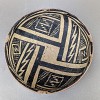
| Culture | Branch | Tradition | Ware | Type |
| Ancestral Pueblo: Greater Mogollon | Greater Salado | Upper Gila (Highland Salado) | Roosevelt Red (Salado Polychrome) Ware | Gila Polychrome |
Type Name: Gila Polychrome |
|
| Period: | 1300 A.D. - 1450 A.D. |
| Culture: | Ancestral Pueblo: Greater Mogollon |
| Branch: | Greater Salado |
| Tradition: | Upper Gila (Highland Salado) |
| Ware: | Roosevelt Red (Salado Polychrome) Ware |
First posted by C. Dean Wilson 2012
Gila Polychrome was described by Gladwin and Gladwin (1930). This type refers to Salado Polychrome forms that developed out of Pinto Polychrome(Crown 1994; Hayden 1957; Lindauer 1994; Young 1982). Gila polychrome appears to have been first produced around A.D. 1300, and it is most abundant at sites dating to the late A.D. 1300s. It lasted into the middle 1400s (Crown 1994; Lindauer 1994). Gila Polychrome is represented by both bowl and jar forms.
Gila Polychrome bowls consistently displays distinct buff or cream colored slips on the decorated surface, although reduced examples may be white to gray. Exterior surfaces of bowls exhibit a red slip that may cover the exterior surface. On jars this red slip may occur as a band around the base and as a band near and around the neck. . Painted decorations are usually in a black organic paint on light colored pastes, sometimes in combinations with painted decorations in red clay. Painted designs of Gila Polychrome usually begin as bands or life lines directly below the rim. These may occur as wide isolated lines that may occur as a series of connected triangles or squares, or as thin lines incorporated into a group of solid motifs. The lines occur on the jar exterior at the bottom of the neck or below the design band, and may be continuous or exhibit a break. Gila Polychrome painted designs tend to be bold, large, and fairly simple. Motifs appear to have been expediently executed with relatively few brush strokes. Painted decorations cover much of the surface, and often result in the creation of negative designs in empty space. Solid designs predominate, although hatched designs may be present. Hatching, when present, tends to be thicker on Gila Polychrome when compared to earlier types. Motifs are often organized into complex rectilinear and curvilinear abstract representational figures. Painted decorations on bowls cover much of the interior surface. This decoration does not extend to the rim, but usually begins with an isolated or incorporated encircling line near the rim, filling the remainder of the interior. Designs on jars often include a banded design framed by lines along the neck and a larger design covering all of the remaining part of the vessel except the lowest part of the base. Areas between painted designs and the unpainted base are often covered by unpainted bands of red slip.
References:
Crown, Patricia L.
1994 Ceramics and Ideology: Salado Polychrome Pottery, University of New Mexico Press, Albuquerque.
Gladwin, Winifred and Harold S. Gladwin
1930 Some Southwestern Pottery Types: Series II. Medallion Papers No. 7, Gila Pueblo, Globe.
Hayden, Julian D.
1957 Excavations, 1940, at the University Indian Ruin, Tucson, Arizona. Technical Series No.5, Southwestern Monuments Association, Globe.
Lindauer, Owen
1994 Systematics of Decorated Wares. In Archaeology of the Salado in the Livingston Mound Study part 2. edited by Jacobs, pp. 635-646. Arizona State University, Office of Cultural Resource Management, Anthropological Field Series 32, Tucson.
Young, Jon Nathan
1982 Salado Polychrome Pottery. In Collected Papers in Honor of John W. Runyan, edited by G. Fitzgerald, pp. 31-57. Papers of the Archaeological Society of New Mexico, Albuquerque Archaeological Society Press, Albuquerque.
Related Photos
 © New Mexico Office of Archaeological Studies, a division of the New Mexico Department of Cultural Affairs.
© New Mexico Office of Archaeological Studies, a division of the New Mexico Department of Cultural Affairs.
The Center for New Mexico Archaeology
7 Old Cochiti Road
Santa Fe, NM 87507
505-476-4404
Fax: 505-476-4448

















